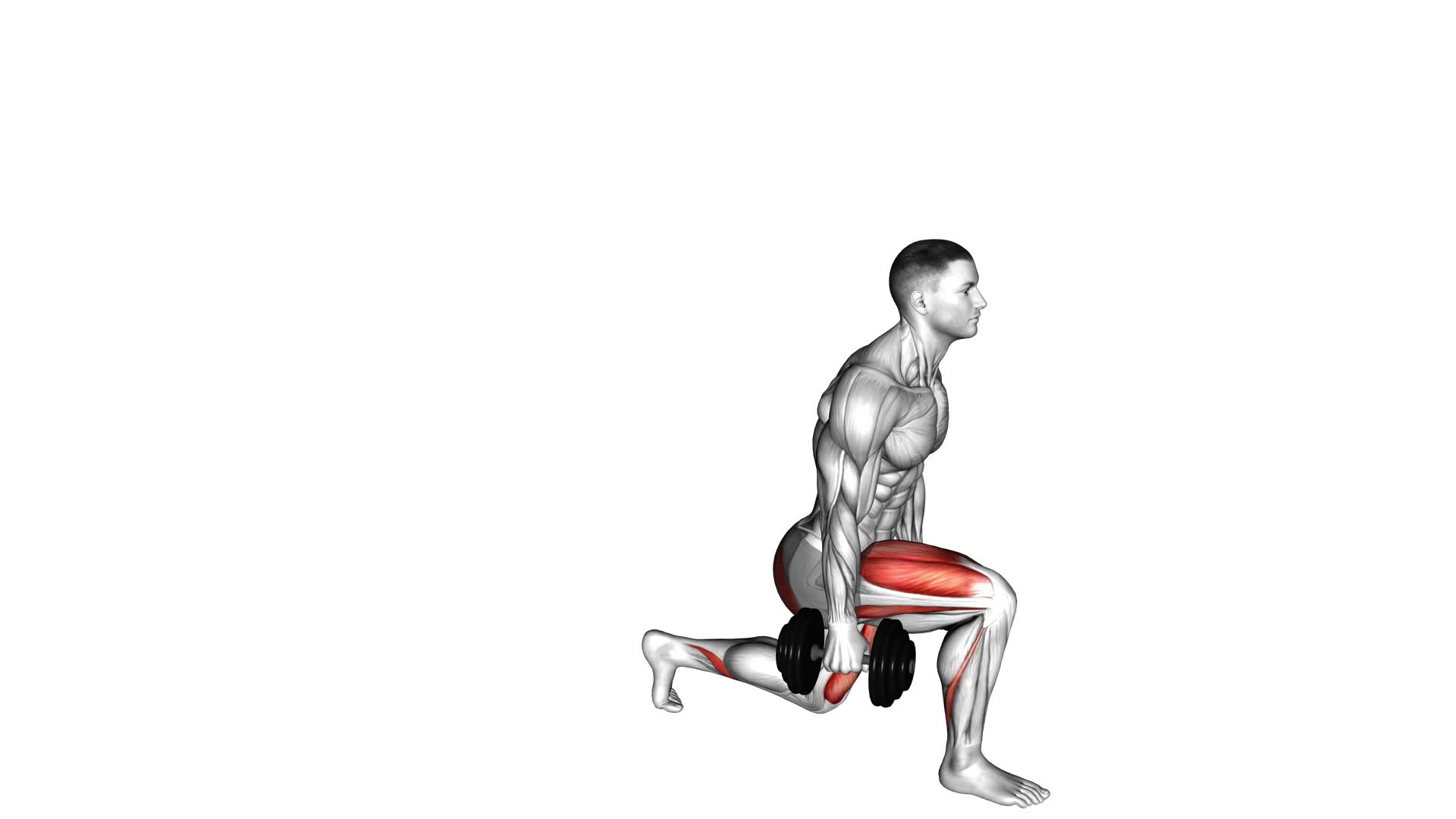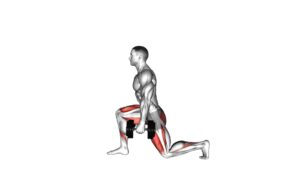Dumbbell Lunge – Video Exercise Guide & Tips

Are you looking to level up your leg workout? The dumbbell lunge is the exercise for you. In this video exercise guide, we'll show you the proper form and technique to maximize your results.
Watch This Exercise Video
We'll also provide variations to challenge yourself and tips to avoid common mistakes.
With the dumbbell lunge, you can strengthen your legs and improve your overall fitness. So grab your dumbbells and get ready to lunge your way to success!
Key Takeaways
- The dumbbell lunge strengthens lower body muscles such as quadriceps, hamstrings, and glutes.
- It improves balance and stability.
- The dumbbell lunge promotes functional movement patterns.
- Using variations of the dumbbell lunge can enhance muscle growth and increase resistance and intensity.
Benefits of the Dumbbell Lunge
You will frequently experience the benefits of the Dumbbell Lunge in your fitness routine. This exercise offers a variety of variations that target different muscle groups and provide unique benefits.
One of the main advantages of the Dumbbell Lunge is its ability to strengthen your lower body, specifically your quadriceps, hamstrings, and glutes. By holding dumbbells in your hands, you increase the resistance and intensity of the exercise, leading to greater muscle development.
Another benefit of the Dumbbell Lunge is its ability to improve your balance and stability. As you step forward and lower your body into the lunge position, you engage your core muscles to maintain control and stability. This not only enhances your performance in other exercises but also helps prevent injuries by strengthening your supporting muscles.
Furthermore, the Dumbbell Lunge promotes functional movement patterns that mimic real-life activities. By lunging forward, you simulate movements like climbing stairs or getting up from a seated position. This translates into improved overall mobility and agility.
Incorporating dumbbell lunge variations into your fitness routine can also challenge different muscle fibers and enhance muscle growth. By performing reverse lunges, walking lunges, or lateral lunges, you engage different muscle groups and add variety to your workouts.
Proper Form and Technique
To ensure proper form and technique during the Dumbbell Lunge, focus on maintaining a stable and controlled movement throughout each repetition. This exercise can be highly effective in targeting multiple muscle groups, such as the quadriceps, hamstrings, glutes, and calves. However, to maximize your results and prevent common errors, it's important to pay attention to a few key points.
First, start by standing tall with your feet hip-width apart. Hold a dumbbell in each hand, with your arms fully extended by your sides. Take a step forward with your right foot, ensuring that your knee is directly above your ankle. Lower your body by bending both knees, keeping your back straight and your core engaged. Aim to lower your body until your right thigh is parallel to the ground. Push through your right heel to return to the starting position, and repeat on the other side.
To avoid common errors, make sure to keep your chest lifted and your shoulders relaxed throughout the movement. Avoid leaning too far forward or backward, as this can put unnecessary strain on your lower back. Additionally, ensure that your front knee doesn't extend past your toes, as this can increase the risk of injury.
Variations to Challenge Yourself
Now let's talk about some variations to challenge yourself during dumbbell lunges.
One way to increase the difficulty is by using progressive overload techniques, such as adding more weight or increasing the number of repetitions.
Another option is to switch between unilateral and bilateral lunges, which helps to target different muscle groups and improve balance and stability.
These variations will help you push your limits and continue making progress in your workouts.
Progressive Overload Techniques
To challenge yourself and continue making progress with the dumbbell lunge exercise, try incorporating variations that increase the intensity and demand on your muscles.
One technique you can use is overload progression, which involves gradually increasing the weight or resistance you use for the exercise. This can be done by using heavier dumbbells or adding ankle weights.
Another way to challenge yourself is by trying advanced lunge variations, such as the Bulgarian split squat or the walking lunge with a twist. These variations engage different muscle groups and require more balance and stability.
By incorporating these progressive overload techniques and advanced variations, you can push your muscles to work harder and continue improving.
Now, let's move on to the next section to explore the differences between unilateral and bilateral lunges.
Unilateral Vs Bilateral Lunges
When performing the dumbbell lunge exercise, you can challenge yourself and increase the intensity by incorporating variations that involve unilateral and bilateral lunges.
Unilateral lunges refer to lunges that are performed one leg at a time, while bilateral lunges involve using both legs simultaneously.
Unilateral lunges have several advantages over bilateral lunges. First, they help to improve balance and stability as you're required to engage your core muscles to maintain proper form. Additionally, unilateral lunges help to correct muscle imbalances by allowing you to focus on each leg individually. This can help to prevent injuries and improve overall leg strength.
Common Mistakes to Avoid
To ensure you perform the dumbbell lunge correctly, there are a few common mistakes you should avoid.
One of the most important things to watch out for is form errors, such as leaning too far forward or allowing your knee to extend past your toes.
It's also essential to maintain proper technique, which includes keeping your chest up and engaging your core.
Lastly, don't forget to prioritize injury prevention by starting with lighter weights and gradually increasing the intensity as you become more comfortable and confident in your form.
Form Errors to Avoid
Avoid leaning forward excessively during the dumbbell lunge exercise to maintain proper form and prevent strain on your lower back. Leaning forward too much is one of the common form mistakes that people make during this exercise. To correct this error, focus on keeping your torso upright and your back straight throughout the movement.
Here are two tips to help you correct form errors:
- Engage your core: Activating your core muscles will help stabilize your body and maintain proper posture during the exercise.
- Take smaller steps: Instead of taking large strides, take smaller steps to ensure that you can maintain balance and control throughout the lunge.
Proper Technique Tips
To maintain proper form and avoid common mistakes, you should focus on engaging your core and taking smaller steps during the dumbbell lunge exercise.
Lunges are a great exercise for beginners as they target multiple muscle groups, including the quadriceps, hamstrings, and glutes. However, it's important to perform them correctly to maximize their effectiveness and prevent injuries.
One common mistake isn't engaging your core, which can lead to poor balance and stability. To avoid this, make sure to tighten your abdominal muscles throughout the movement.
Another mistake is taking too large of a step, which can strain your knee joints. Instead, focus on taking smaller steps and maintaining a 90-degree angle in both knees.
If you're just starting out, you can also modify the lunge by using bodyweight only or holding onto a chair or wall for balance.
Injury Prevention Tips
Engage your core and take smaller steps to prevent injuries during the dumbbell lunge exercise. Injuries can happen if you don't prepare your body properly before starting any exercise. Here are some injury prevention tips to keep in mind:
- Incorporate injury prevention exercises into your warm-up routine. This can include dynamic stretches, mobility exercises, and activation drills to prepare your muscles and joints for the movements ahead.
- Focus on proper form and technique. Make sure you maintain a straight back, keep your chest up, and step forward with control. Avoid leaning too far forward or letting your knee collapse inward.
Tips for Maximizing Results
For maximum results, incorporate these tips into your dumbbell lunge routine.
To maximize intensity during your dumbbell lunges, choose a weight that challenges you but still allows you to maintain proper form. The best dumbbell weight will vary depending on your fitness level and strength, so start with a weight that feels challenging but manageable. As you progress, gradually increase the weight to continue challenging your muscles and promoting growth.
In addition to selecting the appropriate dumbbell weight, focus on maintaining proper form throughout the exercise. Keep your chest up, shoulders back, and core engaged to ensure you're targeting the correct muscles and minimizing the risk of injury. It's also important to take a controlled and steady pace when performing the dumbbell lunges. Rushing through the exercise can compromise your form and reduce the effectiveness of the movement.
To further maximize your results, consider incorporating variations of the dumbbell lunge into your routine. Reverse lunges, walking lunges, and lateral lunges all target different muscle groups and can help prevent plateaus in your progress. By constantly challenging your muscles with different variations, you can continue to see improvements in strength, endurance, and overall fitness.
Now that you know how to maximize your results with the dumbbell lunge, let's explore how to incorporate this exercise into your workout routine.
Incorporating the Dumbbell Lunge Into Your Workout Routine
Start by including the dumbbell lunge as a key exercise in your workout routine. This exercise targets multiple muscle groups, including your quadriceps, glutes, and hamstrings, making it a great choice for strengthening and toning your lower body. Incorporating weights into your dumbbell lunges can add an extra challenge and help you build even more strength.
Here are a few ways you can incorporate the dumbbell lunge with weights into your workout routine:
- Start with bodyweight lunges: If you're new to lunges or just starting to incorporate them into your routine, begin by performing bodyweight lunges. Focus on maintaining proper form and gradually increasing the number of repetitions you can do.
- Progress to dumbbell lunges: Once you feel comfortable with bodyweight lunges, you can start adding dumbbells to increase the intensity. Hold a dumbbell in each hand with your arms by your sides and perform the lunge movement as usual.
- Try unilateral lunges: To further challenge your muscles and improve balance, you can try performing unilateral lunges. Instead of alternating legs, focus on performing lunges with one leg at a time. This will require more stability and engage your muscles differently.
- Increase the weight gradually: As you get stronger, gradually increase the weight of the dumbbells you're using. This will help you continue to challenge your muscles and make progress over time.
Incorporating the dumbbell lunge into your workout routine can help you build strength and improve your lower body muscle tone. Start with bodyweight lunges, progress to using dumbbells, and consider trying unilateral lunges for an added challenge. Remember to increase the weight gradually as you get stronger.
Frequently Asked Questions
How Heavy Should the Dumbbells Be for Performing the Dumbbell Lunge?
To determine how heavy the dumbbells should be for performing the dumbbell lunge, consider your individual strength and fitness level. Start with lighter weights and gradually increase as you become more comfortable and proficient with the exercise.
Keep in mind that using heavier dumbbells can provide a greater challenge and help build strength and muscle.
Incorporating dumbbell lunge variations into your routine can target different muscles and enhance overall lower body strength.
Can the Dumbbell Lunge Help Improve Balance and Stability?
The dumbbell lunge is a great exercise for improving coordination, balance, and stability. By incorporating dumbbells into the lunge, you not only strengthen your leg muscles but also challenge your core and engage your stabilizer muscles.
This exercise requires you to maintain proper form and control throughout the movement, which helps improve your overall balance. Adding dumbbells to the lunge adds an extra challenge and can further enhance your stability and coordination.
Is It Necessary to Warm up Before Performing the Dumbbell Lunge?
Before performing the dumbbell lunge, it's necessary to warm up. Dynamic warm up exercises can help increase blood flow, loosen up your muscles, and prepare your body for the workout. This helps reduce the risk of injury and allows you to perform the exercise more effectively.
When performing the dumbbell lunge, it's important to maintain proper form. Keep your chest up, core engaged, and take a controlled step forward while keeping your knee aligned with your ankle.
Can the Dumbbell Lunge Be Modified for Individuals With Knee or Hip Issues?
If you have knee or hip issues, you may need to modify the dumbbell lunge to avoid further strain.
There are alternative exercises that can be performed to target the same muscle groups without causing discomfort.
Be sure to consult with a fitness professional or physical therapist who can provide you with modified modifications that suit your specific needs.
It's important to prioritize your safety and well-being during your workouts.
How Often Should the Dumbbell Lunge Be Included in a Workout Routine for Optimal Results?
For optimal results, include the dumbbell lunge in your workout routine regularly. Vary the frequency based on your fitness level and goals. As a general guideline, aim to perform the dumbbell lunge 1-3 times per week.
This exercise can be easily modified by using different variations such as alternating lunges or walking lunges. By incorporating different variations and adjusting the frequency, you can challenge your muscles and continue to make progress in your fitness journey.
Conclusion
Overall, the dumbbell lunge is a highly effective exercise that targets multiple muscle groups and can help improve strength, balance, and coordination.
By maintaining proper form and technique, challenging yourself with variations, and avoiding common mistakes, you can maximize your results and incorporate the dumbbell lunge into your workout routine.
So grab those dumbbells, lunge away, and enjoy the benefits this exercise has to offer.

Author
Years ago, the spark of my life’s passion ignited in my mind the moment I stepped into the local gym for the first time. The inaugural bead of perspiration, the initial endeavor, the very first surge of endorphins, and a sense of pride that washed over me post-workout marked the beginning of my deep-seated interest in strength sports, fitness, and sports nutrition. This very curiosity blossomed rapidly into a profound fascination, propelling me to earn a Master’s degree in Physical Education from the Academy of Physical Education in Krakow, followed by a Sports Manager diploma from the Jagiellonian University. My journey of growth led me to gain more specialized qualifications, such as being a certified personal trainer with a focus on sports dietetics, a lifeguard, and an instructor for wellness and corrective gymnastics. Theoretical knowledge paired seamlessly with practical experience, reinforcing my belief that the transformation of individuals under my guidance was also a reflection of my personal growth. This belief holds true even today. Each day, I strive to push the boundaries and explore new realms. These realms gently elevate me to greater heights. The unique combination of passion for my field and the continuous quest for growth fuels my drive to break new ground.







